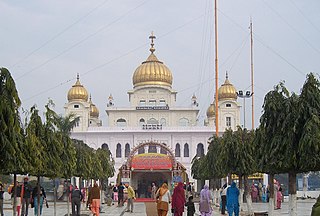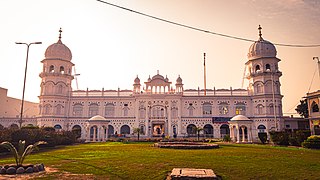
Nankana Sahib is a city and capital of Nankana Sahib District in the Punjab province of Pakistan. It is named after the first Guru of the Sikhs, Guru Nanak, who was born in the city and first began preaching here. Nankana Sahib is the most important religious site for the Sikh religion. It is located about 91 km (57 mi) west of Lahore and about 75 km (47 mi) east of Faisalabad. According to the census of 2017 the city has a population of 79,540 inhabitants. Until 2005, it was a part of the Sheikhupura District.
The following outline is provides an overview of Sikhism, or Sikhi.

Anandpur Sahib, sometimes referred to simply as Anandpur, is a city in Rupnagar district (Ropar), on the edge of Shivalik Hills, in the Indian state of Punjab. Located near the Sutlej River, the city is one of the most sacred places in Sikhism, being the place where the last two Sikh Gurus, Guru Tegh Bahadur and Guru Gobind Singh, lived. It is also the place where Guru Gobind Singh founded the Khalsa Panth in 1699. The city is home to Takhat Sri Kesgarh Sahib, Third of the five Takhts in Sikhism.

Majha is a region located in the central parts of the historical Punjab region split between India and Pakistan. It extends north from the right banks of the river Beas, and reaches as far north as the river Jhelum. People of the Majha region are given the demonym "Mājhī" or "Majhail". Most inhabitants of the region speak the Majhi dialect, which is the basis of the standard register of the Punjabi language. The most populous city in the area is Lahore on the Pakistani side, and Amritsar on the Indian side of the border.
The Tat Khalsa, also romanised as Tatt Khalsa, known as the Akal Purkhias during the 18th century, was a Sikh faction that arose from the schism following the passing of Guru Gobind Singh in 1708, led by his widow Mata Sundari, opposed to the religious innovations of Banda Singh Bahadur and his followers.

Gurdwara Sis Ganj Sahib is one of the nine historical Gurdwaras in Delhi. It was first constructed in 1783 as a small shrine by Baghel Singh to commemorate the martyrdom site of the ninth Sikh Guru, Guru Tegh Bahadur and was probably expanded after Indian Rebellion of 1857 or after Partition of India. Before its construction the Mughal Kotwali was situated here. After the Indian Rebellion of 1857 the Mughal Kotwali was demolished by the British.and the land was given to the Sikhs because the Sikh Maharaja of Patiala and other Sikh soldiers helped the British to defeat the Mughal soldiers by providing large numbers of ammunition and soldiers. Its current building was made by Rai Bahadur Narain Singh a contractor who build most of roads in Lutyens New Delhi construction under British Rule. Situated in Chandni Chowk in Old Delhi, it marks the site where the ninth Sikh Guru was beheaded on the orders of the Mughal emperor Aurangzeb on 11 November 1675. The Sikh regiment of the Indian army salute the Sis Ganj Gurudwara before saluting the president of India since 1979, the only instance of saluting twice in the Republic Day parade by a regiment of Indian army.

Baba Deep Singh is revered among Sikhs as one of the most hallowed martyrs in Sikhism. He is remembered for his sacrifice and devotion to the teachings of the Sikh Gurus. Baba Deep Singh was the first head of Misl Shaheedan Tarna Dal – an order of the Khalsa military established by Nawab Kapur Singh, the then head of Sharomani Panth Akali Buddha Dal. The Damdami Taksal also state that he was the first head of their order.

The Nankana massacre in Nankana Sahib gurdwara on 20 February 1921, at that time a part of the British India but today in modern-day Pakistan. Between 140 and 260 Sikhs were killed, including children as young as seven, by the Udasi Custodian Mahant Narayan Das and his mercenaries, in retaliation for a confrontation between him and members of the reformist Akali movement who accused him of both corruption and sexual impropriety. The event forms an important part of Sikh history. In political significance, it comes next only to Jallianwala Bagh massacre of April 1919. The saga constitutes the core of the Gurdwara Reform Movement started by the Sikhs in early twentieth century.

Baghel Singh was a Military general in the Punjab region in the northern part of the Indian subcontinent in the 18th century. He rose to prominence in the area around Sutlej and Yamuna. Singh joined the Singh Krora Misl, one of the misls during Sikh Confederacy. In 1765, Singh became the leader of the misl.

Bhai Taru Singh was a prominent Sikh martyr known for sacrificing his life, for protecting his Sikh values, by having had his head scalped rather than cutting his hair and converting to Islam.

Gurū Nānak, also referred to as Bābā Nānak, was the founder of Sikhism and is the first of the ten Sikh Gurus. His birth is celebrated worldwide as Guru Nanak Gurpurab on Katak Pooranmashi, i.e. October–November.

Gurdwara Fatehgarh Sahib is a Sikh gurdwara or place of worship in the city of Fatehgarh Sahib in the Indian state of Punjab. The gurdwara marks the 1710 conquest of the city by the Sikhs under the leadership of Banda Singh Bahadur. Sikhs captured the area and razed the fort built by Ferozshah Tughlaq to the ground.

Gurdwara Janam Asthan, also referred to as Gurdwara Nankana Sahib, is a highly revered gurdwara that is situated at the site where the founder of Sikhism, Guru Nanak, was born. The shrine is located in Nankana Sahib, Punjab, Pakistan.

Hazur Sahib, also known as Takht Sachkhand Sri Hazur Abchalnagar Sahib, is one of the five takhts in Sikhism. The gurdwara was built between 1832 and 1837 by Maharaja Ranjit Singh (1780–1839). It is located on the banks of the Godavari River at the city of Nanded in the state of Maharashtra, India.

Bhai Tara Singh Wan was an eighteenth-century Sikh martyr. He was from the village of Wan, also known as Wan Tara Singh and Dall-Wan now in Tarn taran district tehsil bhikhiwind of the Eastern Punjab.
Shaheed Ganj Mosque, originally named the Abdullah Khan Mosque, was a mosque in Lahore, Punjab, Pakistan. The Mosque was commissioned in 1722 during the reign of Mughal Emperor Muhammad Shah and built by Abdullah Khan construction was completed in 1753 during the reign of Ahmad Shah Bahadur. It was constructed next to the shrine of Pir Shah Kaku. Sikh rule began in 1762, the Gurdwara Bhai Taru Singh was built afterwards within the same grounds. The mosque site was under dispute during British rule, but was demolished by Sikhs on the night of 8 July 1935.
Lakhi Rai Bhatti was a ruler of Khairpur, in Bahawalpur, Pakistan. Later his state was captured by the Baloch tribes with the support of Ahmad Shah Abdali in 18th century. Raav is the Indian title for kings used in medieval India.

Gurdwara Shaheed Bhai Taru Singh or Gurdwara Shahidi Asthan Bhai Taru Singh ji is a Sikh Gurdwara at Naulakha Bazaar in Lahore, Pakistan, which commemorates the spot where Bhai Taru Singh was executed. The shrine was built on the grounds of the Shaheed Ganj Mosque, leading to a legal dispute over ownership that began in 1850. British, and later Pakistani, courts upheld the right of Sikhs to maintain a place of worship at the site. While a settlement was being negotiated by British authorities, a group of Sikhs demolished the mosque on 7–8 July 1935, triggering communal riots.In December of 2022, the official Gurdwara’s doors where locked by the local people was turned into a mosque.

















